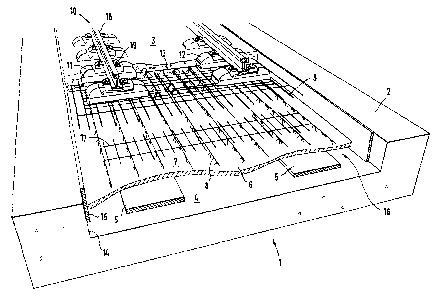Some of the information on this Web page has been provided by external sources. The Government of Canada is not responsible for the accuracy, reliability or currency of the information supplied by external sources. Users wishing to rely upon this information should consult directly with the source of the information. Content provided by external sources is not subject to official languages, privacy and accessibility requirements.
Any discrepancies in the text and image of the Claims and Abstract are due to differing posting times. Text of the Claims and Abstract are posted:
| (12) Patent: | (11) CA 2592757 |
|---|---|
| (54) English Title: | FIXED TRACK BED FOR RAIL VEHICLES |
| (54) French Title: | VOIE FIXE POUR VEHICULES FERROVIAIRES |
| Status: | Granted and Issued |
| (51) International Patent Classification (IPC): |
|
|---|---|
| (72) Inventors : |
|
| (73) Owners : |
|
| (71) Applicants : |
|
| (74) Agent: | SMART & BIGGAR LP |
| (74) Associate agent: | |
| (45) Issued: | 2010-12-07 |
| (86) PCT Filing Date: | 2006-10-12 |
| (87) Open to Public Inspection: | 2007-05-24 |
| Examination requested: | 2007-07-19 |
| Availability of licence: | N/A |
| Dedicated to the Public: | N/A |
| (25) Language of filing: | English |
| Patent Cooperation Treaty (PCT): | Yes |
|---|---|
| (86) PCT Filing Number: | PCT/DE2006/001792 |
| (87) International Publication Number: | DE2006001792 |
| (85) National Entry: | 2007-07-04 |
| (30) Application Priority Data: | ||||||
|---|---|---|---|---|---|---|
|
Fixed track bed for rail vehicles which is mounted on elastic elements, with
the concrete support plate being composed of prefabricated plate elements
and a layer of local concrete located thereon, with the prefabricated plate
elements resting on the elastic elements and forming a monolithic composite
with the local concrete.
L'invention concerne une voie fixe pour véhicules ferroviaires, posée sur des éléments élastiques, la plaque porteuse (3) en béton étant constituée de plaques (6) préfabriquées sur lesquelles une couche de béton est coulée sur site, les plaques préfabriquées reposant sur les éléments élastiques et formant un composite monolithique avec le béton coulé sur site.
Note: Claims are shown in the official language in which they were submitted.
Note: Descriptions are shown in the official language in which they were submitted.

2024-08-01:As part of the Next Generation Patents (NGP) transition, the Canadian Patents Database (CPD) now contains a more detailed Event History, which replicates the Event Log of our new back-office solution.
Please note that "Inactive:" events refers to events no longer in use in our new back-office solution.
For a clearer understanding of the status of the application/patent presented on this page, the site Disclaimer , as well as the definitions for Patent , Event History , Maintenance Fee and Payment History should be consulted.
| Description | Date |
|---|---|
| Maintenance Request Received | 2024-10-01 |
| Maintenance Fee Payment Determined Compliant | 2024-10-01 |
| Common Representative Appointed | 2019-10-30 |
| Common Representative Appointed | 2019-10-30 |
| Letter Sent | 2018-05-03 |
| Letter Sent | 2018-05-03 |
| Letter Sent | 2018-05-03 |
| Letter Sent | 2018-05-03 |
| Inactive: Multiple transfers | 2018-04-19 |
| Change of Address or Method of Correspondence Request Received | 2018-03-28 |
| Grant by Issuance | 2010-12-07 |
| Inactive: Cover page published | 2010-12-06 |
| Pre-grant | 2010-09-20 |
| Inactive: Final fee received | 2010-09-20 |
| Letter Sent | 2010-04-06 |
| Notice of Allowance is Issued | 2010-04-06 |
| Notice of Allowance is Issued | 2010-04-06 |
| Inactive: Approved for allowance (AFA) | 2010-03-29 |
| Amendment Received - Voluntary Amendment | 2010-01-20 |
| Inactive: S.30(2) Rules - Examiner requisition | 2009-07-20 |
| Letter Sent | 2008-04-14 |
| Inactive: Correspondence - Prosecution | 2008-03-20 |
| Inactive: Correspondence - Prosecution | 2008-01-21 |
| Inactive: Cover page published | 2007-09-21 |
| Inactive: Notice - National entry - No RFE | 2007-09-19 |
| Inactive: First IPC assigned | 2007-08-01 |
| Application Received - PCT | 2007-07-31 |
| Request for Examination Received | 2007-07-19 |
| All Requirements for Examination Determined Compliant | 2007-07-19 |
| Request for Examination Requirements Determined Compliant | 2007-07-19 |
| National Entry Requirements Determined Compliant | 2007-07-04 |
| Application Published (Open to Public Inspection) | 2007-05-24 |
There is no abandonment history.
The last payment was received on 2010-09-16
Note : If the full payment has not been received on or before the date indicated, a further fee may be required which may be one of the following
Patent fees are adjusted on the 1st of January every year. The amounts above are the current amounts if received by December 31 of the current year.
Please refer to the CIPO
Patent Fees
web page to see all current fee amounts.
Note: Records showing the ownership history in alphabetical order.
| Current Owners on Record |
|---|
| PCM RAIL.ONE AG |
| Past Owners on Record |
|---|
| FRANZ HABAN |
| HEINRICH GALL |
| MARTIN KOWALSKI |